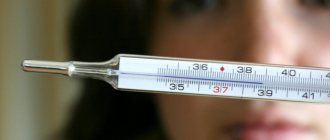Causes
Physiological factors
During the daytime, after physical labor and intense training, a slight increase in temperature may be observed. The reasons are that the muscle fibers contract strongly and heat production increases. The indicators return to normal in a couple of hours. If they do not recover on their own, and the person’s condition worsens, you should consult a doctor.
Low-grade fever also appears with prolonged exposure to the hot sun. This is especially true for young children with imperfect thermoregulatory mechanisms.
Stress
Malfunctions in the central nervous system as a result of emotional reactions disrupt the functioning of the thermoregulatory center (located in the hypothalamus), which leads to an increase in temperature. This often happens to women who undergo hysterical reactions. The temperature can last quite a long time if a person suffers from chronic stress, nervousness or any other conditions related to nerves. It is usually poorly tolerated and is accompanied by the following conditions:
- Chronic fatigue.
- Brokenness.
- Apathy.
- Lack of appetite.
Allergy
Low-grade fever appears suddenly, usually in the first few hours after contact with the allergen. The temperature is accompanied by the following symptoms:
- Tearing.
- Sneezing.
- Eye irritation.
- Runny nose.
The disorder will bother the person throughout the entire period of the allergic reaction (usually until the person is isolated from the allergen). The temperature rarely rises above 37.5 degrees. Against this background, a rash often appears:
- Blisters.
- Swelling.
- Skin redness.
Everything is accompanied by unbearable itching.
ARVI
With any respiratory disease (with the exception of influenza), low-grade fever and weakness are observed. Typically, its pathogens are located in the mucous membrane of the respiratory tract and penetrate the circulatory system. But since their quantity is small, they do not have a strong pyrogenic effect. Everything is accompanied by the following symptoms:
- Body aches.
- Headache.
- Chills.
The temperature rises gradually. Fever lasts no more than 5 days. Low-grade fever usually occurs due to viral infections and colds.
ENT pathology
If a virus or bacteria infects the ear, a fever is caused. It all starts with a short prodromal period (up to 2 days). Symptoms include:
- Heaviness in the head.
- Pain in muscles and joints.
- Drowsiness.
- Pale skin.
- Sparkle in the eyes.
The temperature does not rise above 380. If timely treatment is not provided, the person will feel unwell for 2-3 weeks (this is typical for subacute inflammation). Causes of ear lesions:
- Eustachite.
- Labyrinthitis.
- Otitis externa.
- Otitis media
Sore throat:
- Angina.
- Pharyngitis.
- Laryngitis.
- Tonsillitis.
Diseases of the nose:
- Chronic rhinitis (with exacerbation).
- Vasomotor rhinitis.
- Sinusitis.
Bronchitis and pneumonia
With ordinary bronchitis, the temperature does not rise above 38. The disease lasts from 1 to 2 weeks. The person's condition is satisfactory; slight malaise and fatigue may be present. Specifics include cough, slight pain in the throat and chest area. Low-grade fever is also observed with interstitial pneumonia. The person suffers from weakness and shortness of breath. Other specific manifestations of the disease are practically not expressed.
Viruses
Most often, due to infection, a low temperature appears, which rises to significant levels only with exacerbation of the disease. It is low-grade fever that accompanies coronavirus disease. Localization (source) can be associated with the following systems:
- Respiratory.
- Digestive.
- Urinary.
- Other.
The duration of the disease depends on the cause. In case of exacerbation, the temperature may persist for several months. Common causes associated with viruses are as follows:
- Hepatitis.
- Enteritis.
- Measles.
- Rubella.
- Smallpox.
- Herpes.
HIV infection
A couple of months after infection, a person begins to suffer from regular fever. Some people have a low-grade fever for years. Everything is accompanied by headaches and muscle aches, as well as fatigue. Typically, with HIV infection, the thermometer shows between 37.2 and 37.50. It doesn't change throughout the day. The symptoms are as follows:
- A person gets tired quickly.
- He doesn't eat well.
- Working capacity decreases.
- Chronic weakness.
- Skin lesions in the form of polymorphic rashes.
Bacterial infections
A prolonged low temperature may indicate a slow-moving infection. Typically, a similar reaction is observed with tuberculosis - the thermometer shows no more than 37.5 degrees, but the person feels weak. And at night he sweats a lot. If low-grade fever has been bothering you for several years, this may indicate the following diseases:
- Brucellosis.
- Relapse of Lyme disease.
Symptoms also include joint pain and epidermal lesions.
Helminthiasis
Most types of worms stimulate the production of pyrogenes. When parasites invade, the temperature rises to low levels and is accompanied by disorders of the gastrointestinal tract. If a person has been infected with roundworms, during the period of activity of the larvae he experiences the following:
- Cough.
- Shortness of breath.
- Polymorphous rashes on the body.
The presence of helminth infections can be determined if there is swelling and pain in the joints, as well as a rash.
Changes in hormones in women
During menopause, a woman's estrogen levels decrease. So-called hot flashes occur, and low-grade fever appears. At this moment, the woman feels that her neck and face are burning, and red spots appear on her skin. A woman may have a severe headache, and spots may appear before her eyes. Fever also often appears in the first 3 months of pregnancy. To avoid this, you should consult a doctor.
Low-grade fever (low-grade fever)
Daily body temperature fluctuations
In the absence of pathology, the difference between morning and evening temperatures reaches 0.5-1.0 °C. Daily fluctuations in core temperature occur in accordance with the so-called “biological clock”. If you measure your temperature in the early morning hours, immediately after sleep, its value will be in the range from 35.60C to 36.10C, and this is completely normal. During the day, with increased physical activity, the thermometer shows the usual value around 36.60C. In the evening, the temperature of healthy people tends to rise slightly. This usually occurs between 16.00 and 18.00. For some, the fluctuations are quite significant: in the evening the temperature reaches the borderline level of 37.20C.
Physiological low-grade fever is easily tolerated and does not require taking antipyretics.
Taking medications
The temperature may also increase while taking medications. You should read the instructions; usually the side effects indicate the possibility of increasing it. Some drugs can also inhibit beneficial microflora. This is especially true for medications that have an effect on the nerves.
Other reasons
Other reasons are as follows:
- Intestinal disorders.
- Malfunctions of the endocrine system.
- Autoimmune processes (connective tissue diseases).
- Tumors.
Low-grade fever during exercise and stress
If you are in the heat or in a very heated room, dressed too warmly, this affects your body temperature, causing it to rise. Low-grade fever due to overheating is short-term. As soon as the ambient temperature returns to normal, the body temperature also returns to normal.
The same happens during physical activity, which activates all processes and accelerates blood circulation. During heat and stress, the internal temperature can rise by two degrees or more. In this case, the skin, on the contrary, cools due to the release of sweat, as the hypothalamus strives to establish a balance between the formation and release of heat.
Diagnostics
Since there are many causes of low-grade fever, you need to undergo a whole range of tests to determine the cause. After complaining to the doctor about low-grade fever, you need to do the following:
- Blood analysis. Helps determine the presence of infections or liver damage.
- Bacterioscopy. Not only blood is donated, but also a smear of the mucous systems. Helps determine the presence of bacteria.
- Tests for serological reactions. They help find pathogens of intestinal diseases and acute respiratory viral infections.
- Sonography. Evaluates the condition of the internal organs of the abdominal cavity, joints and endocrine glands.
- X-ray imaging. Helps identify lung problems.
- Invasive research. If the infection concerns the skin.
- Clarifying methods. Determines menopause, pregnancy or allergies.
Thermoneurosis
Some people note an increase in temperature during psycho-emotional stress. This is how the body reacts to stress. Experts call this manifestation temperature neurosis.
To make a diagnosis, it is necessary to exclude other possible factors that lead to the appearance of low-grade fever: infections, chronic diseases. The patient is given a so-called “aspirin test”. If the temperature decreases after taking aspirin, then the cause is an infection. With thermoneurosis, temperature readings after taking aspirin remain unchanged.
Low-grade fever in this case is due to the reaction of the nervous system to physical and psychological overload. This phenomenon is most often encountered by teenagers and people of a neurotic type, who react more severely to stress than others. A previous illness or injury can give impetus to the development of thermoneurosis. In the treatment of thermoneurosis, priority is given to the patient changing his lifestyle, the ability to relax, and cope with stress. Reflexology, meditation, taking soothing herbal remedies, and moderate physical activity have a positive effect. In severe cases, consultation with a psychologist or psychotherapist may be required. The specialist’s task is to teach the patient to cope with stressful situations that provoke thermoneurosis.
Treatment
It all starts with finding the cause of the condition. After this, the following may be prescribed:
- Antibiotic. If the cause of the temperature is infection, a remedy is selected taking into account the type of pathology. For tuberculosis, several drugs are combined at once.
- Antiviral agent. Helps fight hepatitis and HIV infection. They slow down the proliferation of pathogens and reduce the load on the circulatory system. If the infection is intestinal or respiratory, other drugs are chosen.
- Non-steroidal anti-inflammatory drugs. Help reduce pain and stiffness. Selective inhibitors are usually chosen to reduce gastrointestinal side effects.
- Vitamins. Their goal is to strengthen the body, increase immunity and energize a person.
- Hormonal agents. Needed by women experiencing menopause. Usually, a course of hormone treatment completely eliminates the temperature. Combined contraceptives will help with severe premenstrual syndrome.
- Cytostatics. Used together with combination chemotherapy for cancer.
- Infusion solutions. They are needed if viral and bacterial infections become so severe that they cause intoxication of the body. Prevents cerebral edema.
Fever and menstrual cycle
In women, body temperature is interconnected with the menstrual cycle and hormonal fluctuations. During ovulation, symptoms of low-grade fever may occur, which persist until the onset of menstruation. This is an individual physiological norm. In some women, low-grade fever is accompanied by pregnancy. Most often this occurs in the first trimester, which is due to increased production of progesterone. This hormone affects the thermoregulation center in the brain. That is why in pregnant women the temperature can rise to 37.2-37.40C. According to statistics, a similar phenomenon occurs in 3-5% of women. Most often, low-grade fever during pregnancy is accompanied by drowsiness, fatigue, and changes in appetite. By 12-14 weeks the situation will normalize.
If low-grade fever during pregnancy is not associated with infection, the increase does not have a negative effect on the development of the fetus. If there are complaints or alarming symptoms, a pregnant woman should undergo an examination to determine the cause of poor health.
How to alleviate the child's condition?
Several recommendations will help your child cope with this unpleasant condition. They are aimed at increasing heat transfer and reducing heat production. In practice, this can be done as follows:
- provide the child with bed rest or a minimum of physical activity;
- try to control the child’s emotions, screams and tantrums contribute to an increase in temperature;
- feed the child as desired, do not insist on feeding if he does not want to eat;
- Monitor the temperature of food, it is also better to avoid hot drinks (no more than 40°C);
- maintain an optimal climate in the room, namely about 20° (+/-2°);
- Give your child plenty of drink, it can be water, compote, juice, tea with raspberries.
These tips will help your child cope with low fever. However, parents should monitor the situation so that if the child’s condition worsens, they can take adequate measures.
Tumors
When a malignant tumor (cancer) appears in the body, the functioning of all organs and systems changes. Oncology affects metabolism. Paraneoplastic syndromes appear, including low-grade fever. When a doctor, when contacted about low-grade fever, does not find viral infections and anemia, he may suspect a malignant tumor.
When cancer breaks down, pyrogens enter the bloodstream. They increase the patient's body temperature. If a person develops tumors, then pre-existing chronic infectious diseases may reach the stage of exacerbation. This is also a possible reason for the temperature to rise to subfebrile levels.
Possible symptoms of paraneoplastic syndromes:
- fever that does not go away when taking anti-inflammatory and antipyretic medications
- Daria's erythema
- acanthosis nigricans
- itchy skin (no rash; no other causes of itching)
- Cushing's syndrome
- hypoglycemia
- anemia, etc.









